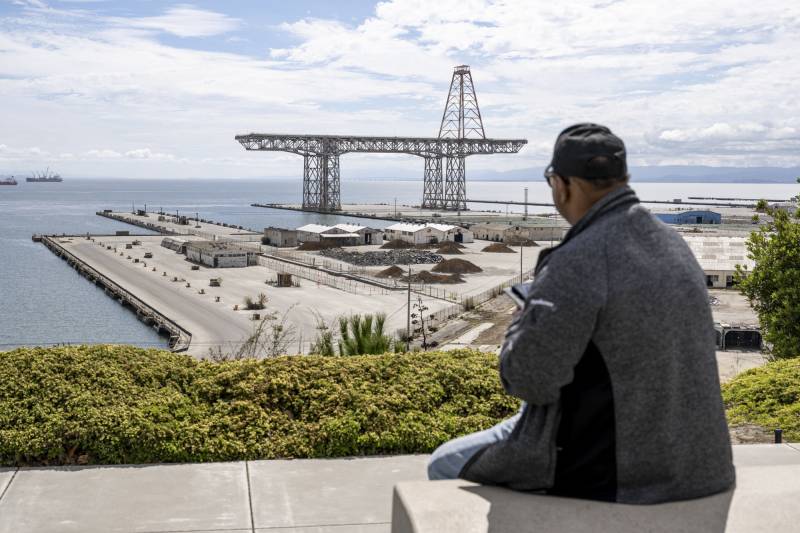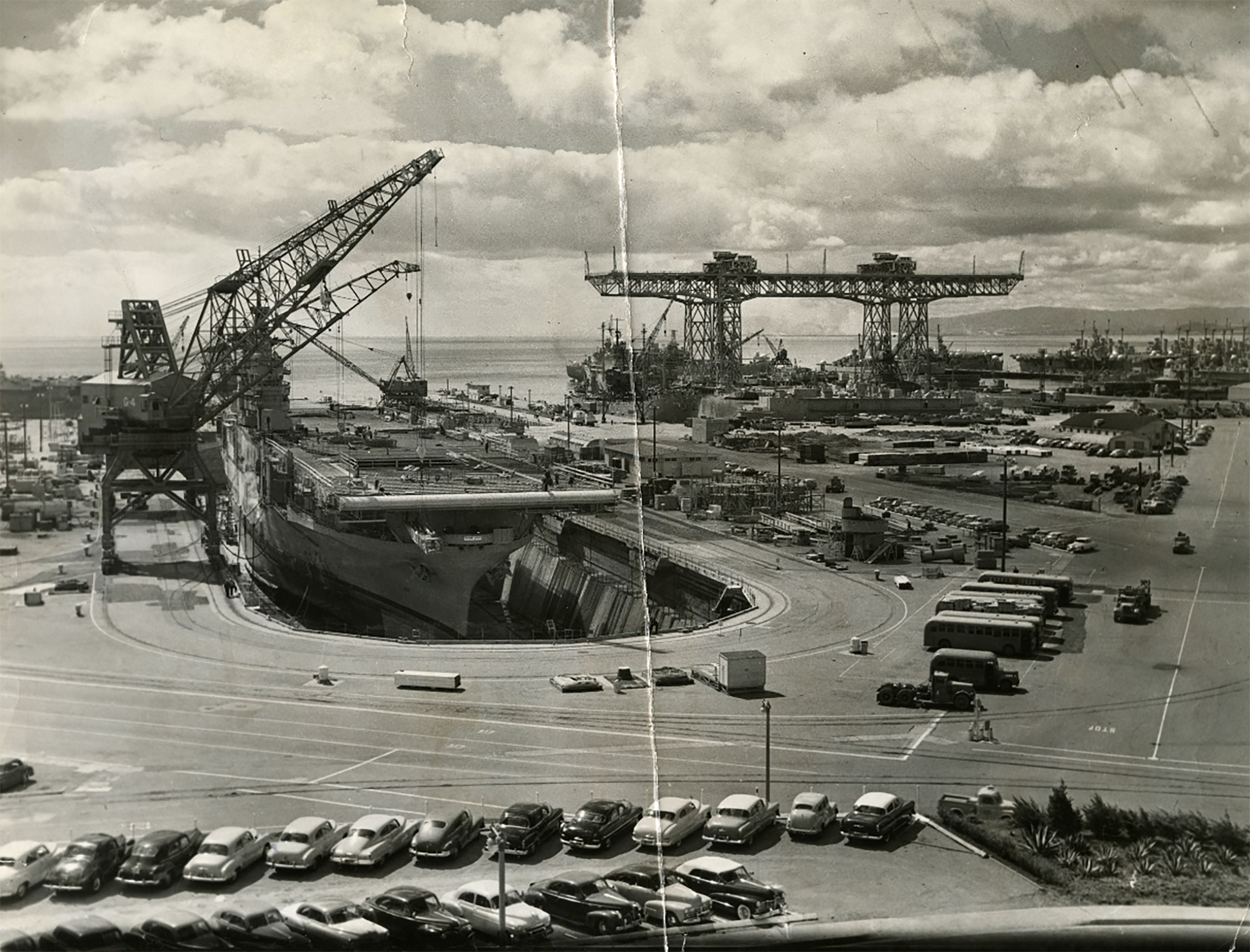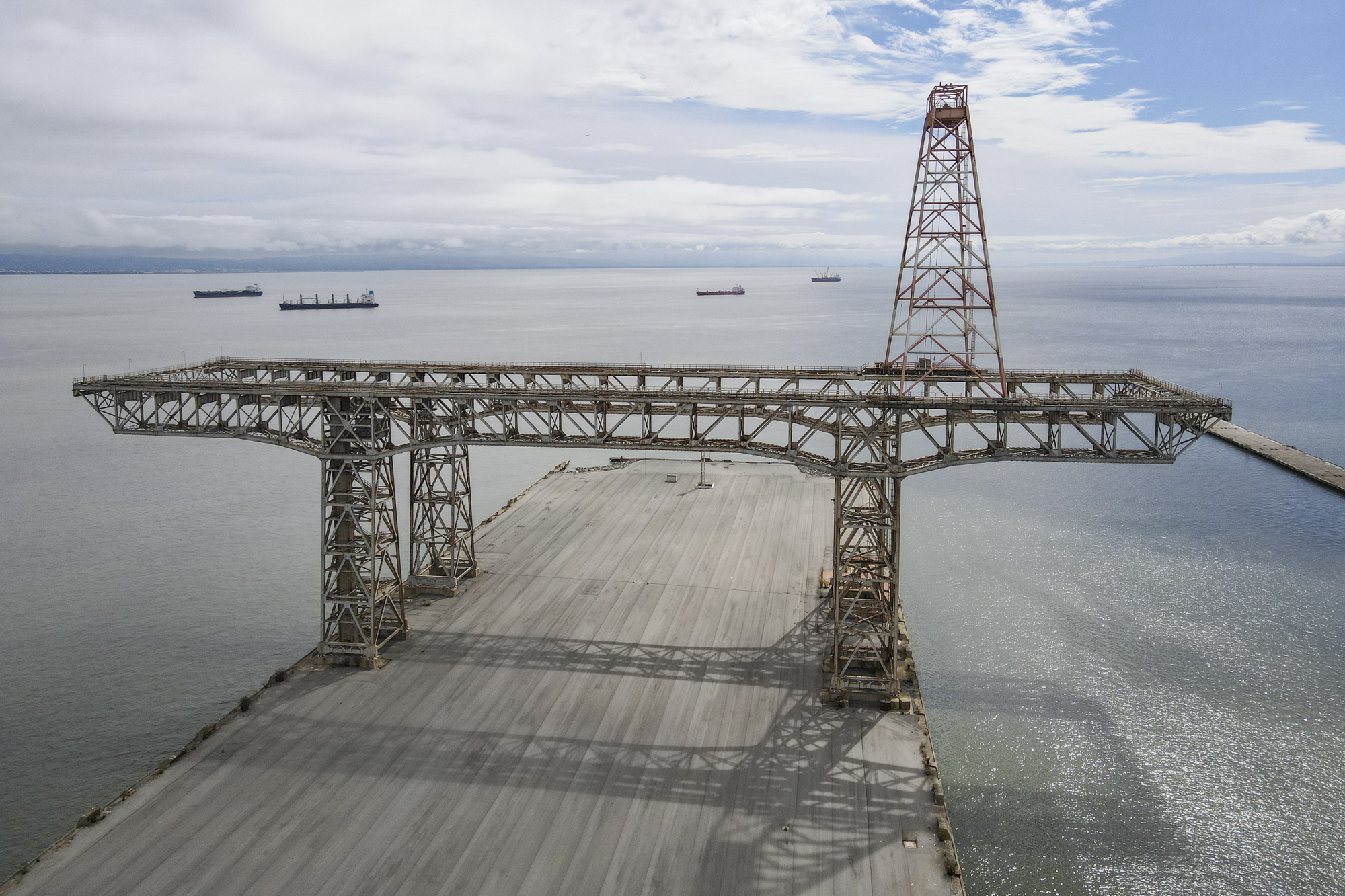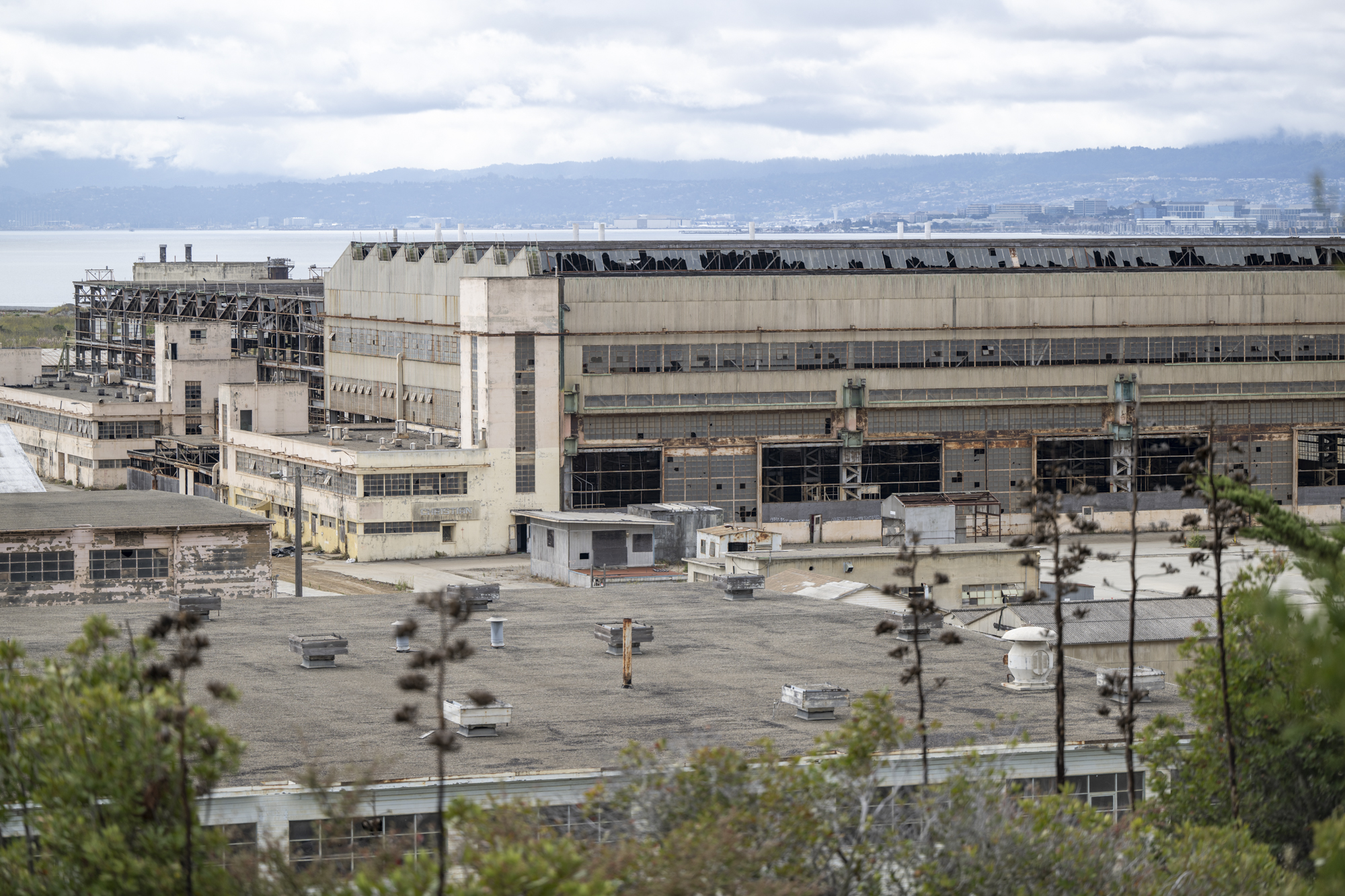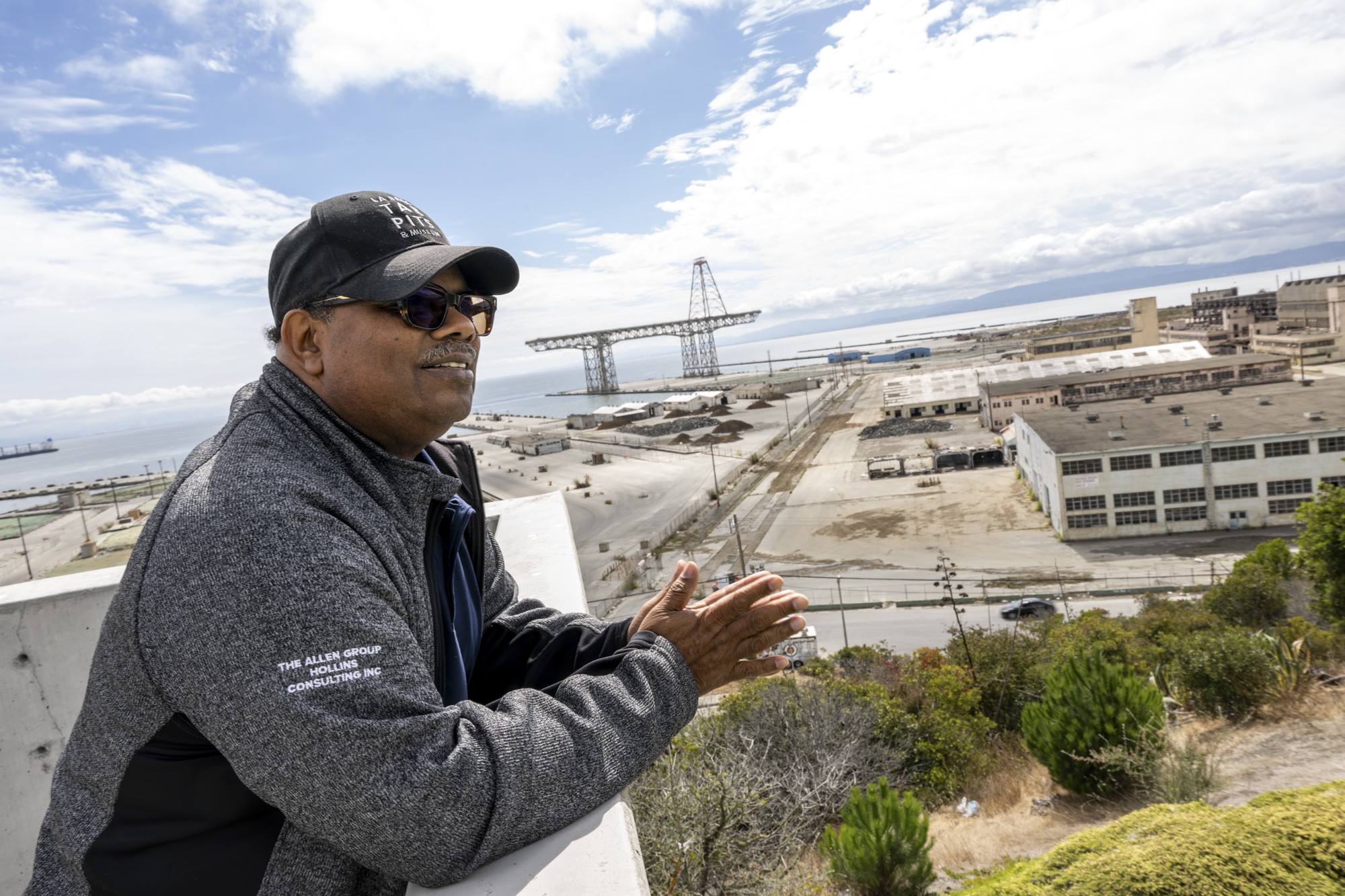Episode Transcript
This is a computer-generated transcript. While our team has reviewed it, there may be errors.
Olivia Allen Price: Every time Olivia Grubert drives over the Bay Bridge from Oakland, she notices this thing perched on the edge of the bay on the south side of the city.
Olivia Grubert: You see this massive structure just kind of all by itself. And it seems that no one really knows too much about it. I keep pointing it out.
Olivia Allen Price: It turns out that metal monolith has a name. It’s called the Hunters Point Gantry Crane. From a distance, you see the structure looks like an outline of a dining table with four legs and a rectangular top on top of that table on one side. A wide arch reaches up to the sky. And this thing is big. So big it can be seen from at least three counties. Olivia sent us this question:
Olivia Grubert: I live in Oakland, and I was curious, can you tell us about the massive crane at Hunters Point? How did it used to operate and why is it still around today?
Olivia Allen Price: The Hunters Point Gantry crane is 450 feet tall and 730 feet long. It weighs as much as the Eiffel Tower. It’s an iconic piece of infrastructure, not unlike the Sutro Tower or the Bay Bridge, but perhaps the more underrated cousin. What else is there to know? A whole lot. I’m Olivia Allen Price. On today’s episode, we dig into the Crane’s history by talking to San Francisco locals who see the crane as a piece of ingenuity, but also as a reminder of how actions by the U.S. Navy decades ago still haunt San Franciscans today. We’ll get into all of that just after a quick break. Stay with us.
[SPONSOR MESSAGE]
Olivia Allen Price: To help us answer Olivia’s question about the Hunters Point Crane, we’ve got KQED climate reporter Ezra David Romero here. Hey, Ezra.
Ezra David Romero: Hey, Olivia. Yeah. Whenever I think of the Hunters Point Crane, I always think of those cranes at the Port of Oakland that you can see from the Bay Bridge. I was always told that they inspired the imperial walkers. You know, those like creatures that walk in the snow in the Star Wars film The Empire Strikes Back. I personally love that scene where the rebel alliance takes down an imperial walker on the snow planet, Hoth.
Olivia Allen Price: But Bay Curious did an episode in 2017 demystifying that idea. George Lucas is on record saying there’s no connection. Sorry, Ezra.
Ezra David Romero: It may not have inspired George Lucas, but I learned the notion of the crane being related to war isn’t farfetched. James Bryant has lived in the Bayview for more than 40 years. He’s known in the community as a neighborhood historian. I took our question asker Olivia Grubert, to meet him.
James Bryant: This is my house right here. I’m not going to disturb my wife. I’m gonna park here. Watch your step.
Ezra David Romero: But from his front porch, he sees the old gantry crane off in the distance every single day.
James Bryant: There it is. What a picture. The west coast Statue of Liberty, right here. The Gantry Crane represents what New York has in their bay, we have in our bay.
Ezra David Romero: To me and Olivia, from this vantage point, it kind of looks like a futuristic metal space dog guarding San Francisco.
James Bryant: It is huge and it’s breathtaking. You ever seen a crane like this anywhere in the world?
Olivia Grubert: I’m really excited we have this here.
Ezra David Romero: To understand how the Hunters Point Gantry Crane came to be. We have to go back in time to the late 1940s when the Cold War started between the United States, the Soviet Union, and the respective allies.
[music]
Ezra David Romero: The crane was built in 1947 for $2.5 million. At this point, it looked like a giant table from afar. On two sides, the crane loaded massive gun turrets on the warships.
James Bryant: The overhead was being operated on two sides of the columns or the boats pulled in and they were being, you know, lifted, loaded.
Ezra David Romero: All together, it could lift over 1 million pounds. The goal was to fix and load up ships fast so they could get back to battle.
James Bryant: The crane was used for loading like four or five ships at once. It was an idea that, you know what, we’re going to war and we need to load these ships like, right now. Because, you know, these ships were major.
Ezra David Romero: The Navy also tested missiles on the crane, Polaris missiles, which are hydrogen bomb tipped. I wasn’t able to find any archival recordings of a missile test from the Hunters Point Crane. But here’s what one sounded like in 1960 being shot out of a submarine off the Florida coast.
Archival Tape: The George Washington goes down some 50 to 60 feet below the surface and the time for launching is at hand.
Ezra David Romero: At Hunters Point, the missiles were originally hurled into the bay and then later retrieved. Later they were shot into midair, but an apparatus prevented them from flight. In the 70s, when the Navy wanted to test stronger Poseidon missiles on the crane, they attached a 170 foot arch to strengthen it. Here’s a Poseidon being launched by the Navy off the Florida coast in 1972.
[Archival Tape]
Ezra David Romero: At the shipyard, the Navy decontaminated ships after atomic bomb tests and established the Naval Radiological Defense Laboratory. This process contaminated the soil in and around the base with radioactive chemicals, heavy metals, and petroleum fuels. The Navy base remained active until 1974 and was used by a private company for ship repair after that. The base was declared one of the nation’s most contaminated sites in 1989. The crane has remained unused for decades. While the history of the crane is quite straightforward, its legacy is complex. On one hand, the Navy brought jobs to the Bay Area, much needed jobs for people who had left the South. The shipyard employed as many as 18,000 people at its peak, many of whom were black. They built in-service ships for wartime efforts.
James Bryant: They came up from Alabama, Mississippi, Texas, and, you know, they were looking for some sort of prosperity. And imagine people who went in there, got jobs, ended up being homeowners.
Ezra David Romero: So, it represented, like, prosperity, like opportunity.
James Bryant: There was two things for people who came up from the south and didn’t have a job. They didn’t have opportunity in those southern states. And it was prosperity because they got to own a home. They got to live in the best weather. You can’t beat this where they can’t beat the Bayview weather, right?
Ezra David Romero: But on the other hand, the hunters point crane is a reminder of another legacy. Radioactive contamination is still on the ground all these years later. The Navy is working on cleaning up the site. And just last year, two soil samples unearthed radioactive objects there. The Navy did not respond to my emails for comment. But in the past, the Navy defended its remedies. Community advocates like James have for years called for a more thorough cleanup of the site.
James Bryant: It could be eradicated. If it was on the other side of town, it would have been gone. You know what I mean? If it was a Sea Cliff, there would have never been an issue because the value of the homes and stuff, it should be prosperity again. That should switch Bayview Hunters Point from none to prosperity. It could provide jobs.
Ezra David Romero: In the late 1970s. James worked for the Navy at the shipyard in public relations.
James Bryant: I said, okay, but there’s something about me that you might know up front. And this was that. I don’t lie. I went along with that project for about two years.
Ezra David Romero: He left that job because he did not agree with a message the Navy wanted to portray about the contamination left at the shipyard. James now owns a public relations firm in the Bayview. All these years later, James is now 70 and still raves about the crane, but is worried about the contamination left in the ground beneath it.
James Bryant: You can almost hear the buildings talk to you. There’s history here that no one is talking about. Somehow the Navy ships that went in there were loaded with the nuclear stuff, which is one of the reasons why it is still sitting there, because it was a little contaminated.
Ezra David Romero: A little contaminated?
James Bryant: Just a little [laughs]
Ezra David Romero: Someone who knows a lot about this contamination and how it could be hurting the community is Arieann Harrison. We’re at her office.
Arieann Harrison How are you? Oh, you look so cute.
Ezra David Romero: Good to see you.
Ezra David Romero: I met Ariana a few years ago. Her mom, Marie Harrison, pushed for the cleanup of the shipyard for decades before passing away in 2019 from lung disease. Ariana took up her mom’s mantle in a way, and now leads the Marie Harrison Community Foundation, which is focused on environmental justice.
Arieann Harrison Right now, we’re still at, you know, absolutely clean up of the shipyard. Even though we know that there’s a really big, huge chance they’re not going to take all that stuff off from under the ground.
Ezra David Romero: Erin grew up very close to the shipyard and believes she was exposed to the radioactive contamination. A local doctor tested her for contaminants and found a bunch of them.
Arieann Harrison: For me to see elevated levels of lead, which we usually see that in low income areas anyway. And manganese and, you know, radioactive isotopes and metals and all that other stuff that’s not good for you. And then to come back positive for PCI 24 — uranium and plutonium. I mean, come on, man, you know. And you have a scientist as saying that your case is that of people that were serving in the military, people that tested positive for this stuff. Come on. What do you do with that information?
Ezra David Romero: Because of all that new information, she’s worried her health issues are related to the contamination. The doctor who took Ariana’s tests and more than 150 others plans to create a registry of their results. She wants to expand testing across the community.
Arieann Harrison I remain hopeful. If you want to get yourself to our early grave, you can stay bitter, right? And stay angry. That was affecting my health, too. I am still angry and I know that and is still hopeful at the same time, for the future, you know. I have a lot of a vested interest in making sure if it’s the last thing I do, that things improve.
Ezra David Romero: Ariana believes a more thorough cleanup is needed. She wants all of the contaminated soil removed from the site, but the Navy has removed some of it. IT solutions also include treating or sealing the contaminated soil under a thick layer of asphalt or dirt to contain it. But she’s also worried those remedies aren’t enough because human caused climate change is expected to raise sea levels. That could push water up from underneath the toxic site and spread the contamination into the bay and the community.
Arieann Harrison: Later on down the line, a year or two or three from now, because we don’t know what the science is projecting, what sea level rise is going to look like, that this stuff that’s under the ground is definitely going to seep out to the Greater Bay Area.
Ezra David Romero: Earlier this year, the Navy acknowledged for the first time that potentially toxic groundwater could surface at the shipyard in just over a decade. They say they’ve taken steps to protect against a 100-year storm and three feet of sea level rise like extending a seawall and a landfill cap. Their findings raise questions about the city’s plan to build thousands of homes here. If and when those homes are built. Many will have a view of the Hunters Point crane. For some, it’s an icon to be celebrated. There’s even a whole fan website for the old crane where they sell merchandise and tell some of the history behind it.
Arieann Harrison: We know that maybe they want to preserve that, which is fine as long as they, you know, do their best to clean up all the crap that’s around it you know. But to me, it signifies that there’s still work to be done. It’s like when you have war, there’s always a fallout.
Ezra David Romero: It’s just that Arieann doesn’t want that fallout to any longer be on the shores of San Francisco. And in her case, the crane is a daily reminder of contamination left in her community.
[Music]
Olivia Allen Price: That was KQED’s Ezra David Romero. Thanks to Olivia Grubert for asking this week’s question. If you’ve got a question you’d like to hear answered on Bay Curious, head to Baycurious.org and ask. Next Monday is the start of Propfest, our podcast series that digs in deep on the propositions on California’s ballot this year. For two weeks, we’ll be dropping a new episode every Monday through Friday, each one covering one of the ten propositions that you’ll be voting on. We hope you’ll tune in so you can vote with confidence on the issues that matter to you. And honestly, the ones that maybe don’t matter to you yet, but you might care more about after you listen. It all kicks off Monday, September 23rd, so be sure you’re subscribed to Bay Curious so you don’t miss a thing. Bay Curious is made in San Francisco at member supported KQED. Our show is made by Amanda Font, Christopher Beal, Ana De Almeida Amaral, and me, Olivia Allen Price. Additional support from Jen Chien, Katrina Schwartz, Maha Sanad, Holly Kernan, and the whole KQED family. I’m Olivia Allen Price. We will see you next Monday. Bye!
